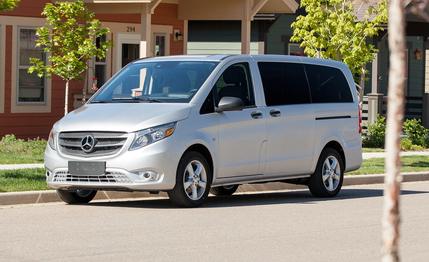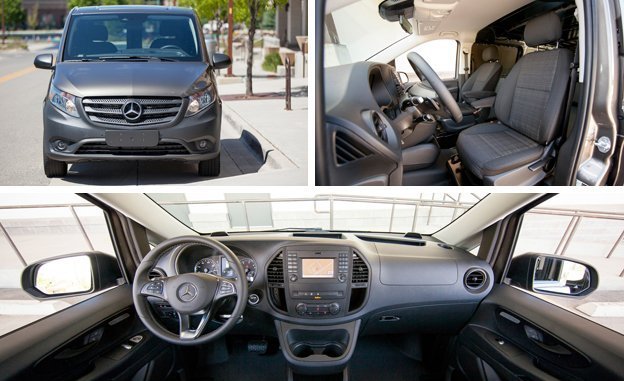 First Drive Review
First Drive Review
Minivans are deeply unsexy, but even the most hardened car guy must admit that a high-zoot Toyota Sienna, Honda Odyssey, or Chrysler Town & Country—with reclining leather thrones, more video screens than a Buffalo Wild Wings, and heaps of other sybaritic delights—is far from uncomfortable. Now comes a Mercedes-Benz entry, the new Metris. Toyota, Honda, and Chrysler: Prepare to be out-pimped!
Actually, y’all are good. The Metris is not a luxury minivan. Yes, it’s a Mercedes, but if you were expecting the Metris to be the proverbial Mercedes-Benz of minivans, it’s not. At least not the way most of America understands the brand. Think of it as a shrunken Sprinter, not an S-class for soccer moms.
The rear-drive Metris is essentially a rechristened version of the Spanish-built Mercedes-Benz Vito that is commonly used in Europe and elsewhere for hotel-shuttle, vanpool, and cargo-hauling duties, and it’s expected to be used in much the same way on these shores. Mercedes does sell a fancy version of the Vito called the V-class, but knowing how few customers exist for such a high-dollar thing here (given the brand’s experience with the R-class), there are no plans to bring that version here.
Only two significant changes were made to make the Vito—er, Metris—palatable to North American buyers: The center console, which can house a manual shifter in the Vito, was ditched in favor of two Big Gulp–sized cup holders, and the Vito’s diesel engines will stay on the other side of the pond while the Metris instead gets a gas-powered 2.0-liter turbocharged four-cylinder and a seven-speed automatic.

Although we only were able to drive Metris cargo and passenger models a few dozen miles each, it took only a few hundred yards to gather some impressions. The driving position feels rather more like that of a C-class than a Sprinter, with the steering wheel dropping low into one’s lap rather than high and flat, à la buslike wheels found in larger vans. And outward visibility is superb.
The 2.0-liter four-cylinder produces a modest 208 horsepower and 258 lb-ft of torque, yet it does a remarkably good job getting the roughly 4850-pound Metris passenger model moving, even with five grown men aboard while trekking through the 8000-to-10,000-foot elevations in Colorado where our preview drive was held.
Even better, with rear-wheel drive and a fully independent suspension—uniquely tuned for cargo and passenger applications—the Metris exhibits surprisingly lively dynamics, offering a taut ride, level cornering, and crisp feel through the steering wheel and the brake pedal, attributes we haven’t felt in a van this size, well, maybe ever. And despite our test vehicles being preproduction models, the Metris is remarkably quiet. This is a stunning achievement, particularly for a cargo van.
Like the Sprinter, the Metris has a T-square profile that allows the windowless cargo version to be upfitted in almost infinite ways, and its 202.4-inch length and 75.2-inch roof height make it about as capacious as a van can get while still being able to fit in a standard garage. (The length is within half an inch of the Odyssey and the Town & Country, about a foot longer than a long-wheelbase Ford Transit Connect. The Benz towers over those vans by three to seven inches.) Loading bulky and/or heavy stuff is facilitated by available 270-degree-opening, barn-style doors at the back and a flat load floor that is barely higher than one’s knees while also being wide enough to accommodate a pallet. The Metris cargo van can carry up to 2502 pounds, and all Metrises are rated to tow a 4960-pound trailer.

Just because the Metris is garage-friendly doesn’t make the seven- or eight-passenger model appropriate for modern families, especially next to the many cushy minivans on the market. While the driver grips a wonderfully contoured steering wheel and fiddles with classy controls and switches cribbed from the C-class parts bin, from the B-pillar back, the Metris feels like it came from an earlier era when passengers needed only seats and, well, seats. And those flat, hard second- and third-row benches (with a two- or a three-passenger second row) are about as cosseting as those of a city bus. Although they can be removed, they do not recline or fold into the floor. Spend any time in the second row and you’ll realize that armrests are a vastly underappreciated part of any automobile, and the lack thereof forces Metris passengers to brace themselves against the hard, plastic-lined sliding doors during tight corners. Also revealing the Metris’s utilitarian purpose are its fixed rear windows, loud rear-seat air conditioning, and the lack of an available sunroof and leather seats. There’s no center console to hold purses or iPads. Want rear-seat entertainment? Look out the window, kid.
For its part, Mercedes has no illusions of its Metris shuttling the offspring of the well-heeled to posh private schools. Mercedes says that fully half of all Metris vans imported here will be passenger models, but most of those are expected to go to limousine companies, with the rest going to taxi and shuttle services. Mercedes is perfectly willing to sell them to private customers, but that probably won’t happen often.
Regardless of configuration, all Metris models will come with load-adaptive stability control and crosswind assist, as well as a plethora of airbags (six in the cargo model, eight in the passenger version). Optional on all are a hands-free parking system, hill-start assist, Lane Keeping Assist, Collision Prevention Assist, Blind Spot Assist, parking sensors, a rearview camera, and engine stop-start. A button on the dash allows the powertrain to be switched among Eco, Comfort, and Manual modes.
Come October, the Metris will be offered through the same dealer network that sells and services Sprinters. Prices will start at $29,945 for the cargo model—making it the cheapest new Mercedes-Benz you can buy—while passenger versions will start at $33,495. Options come à la carte, and there are well over 100 of them. Heavily optioned, don’t be surprised to see prices climb past $40K, considerably more than some of its competitors. In this respect, and in its driving manners, the Metris is very much a Mercedes-Benz.